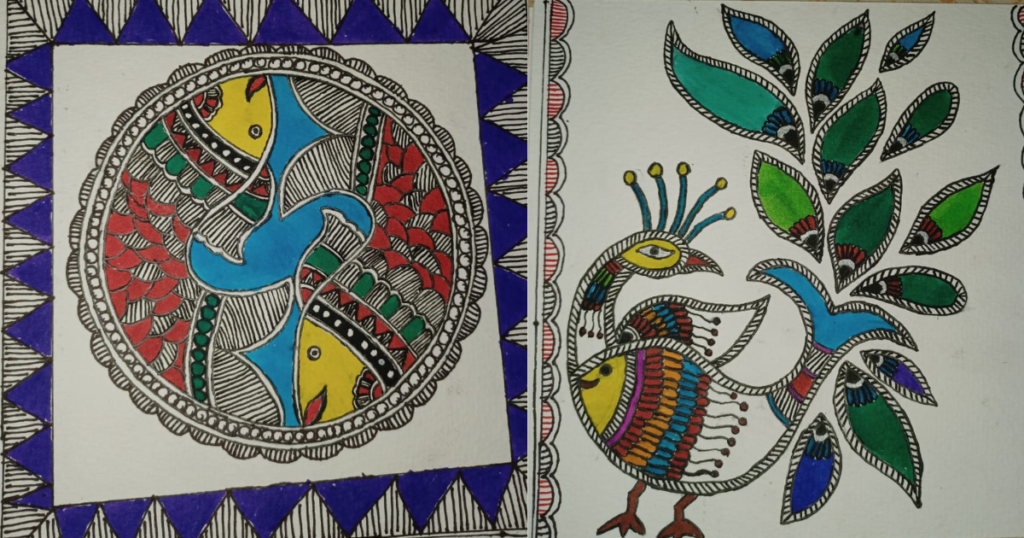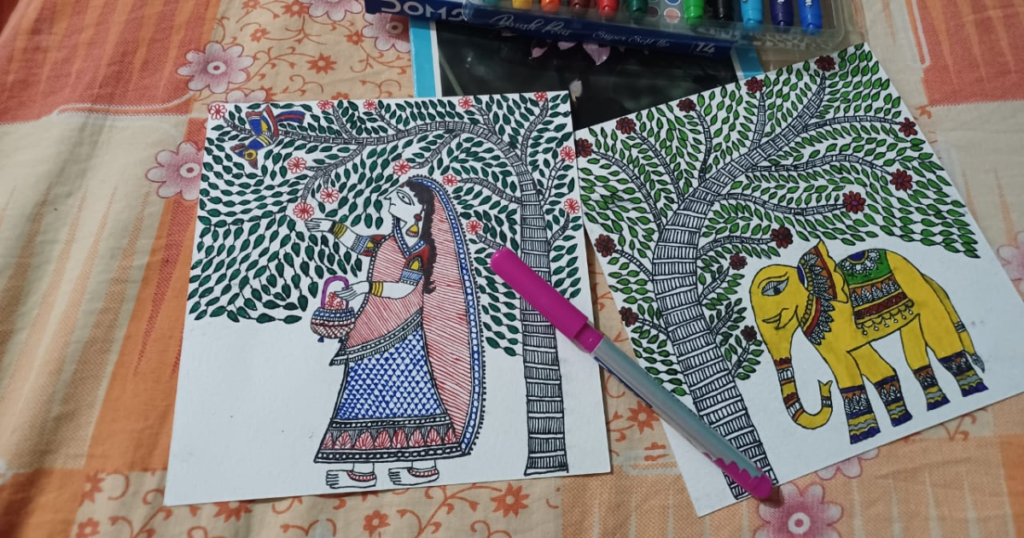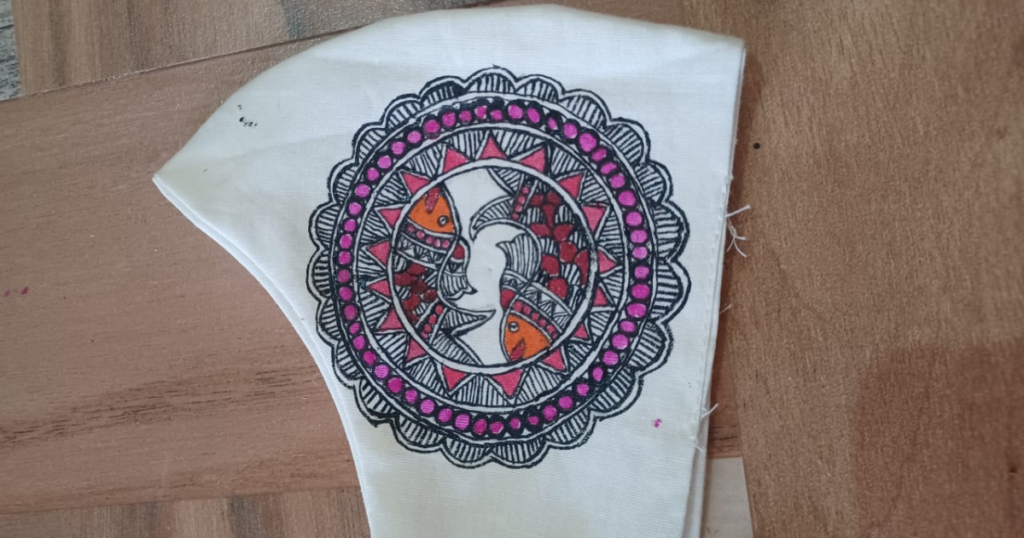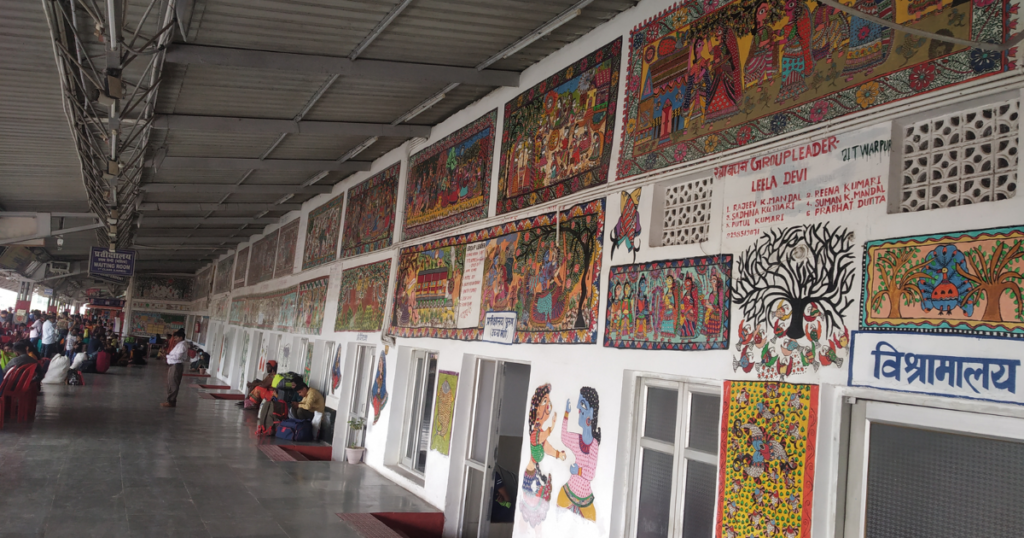Mithila paintings were traditionally created by women of various communities in the Mithila region of the Indian subcontinent. Madhubani art is a folk painting practiced in Mithila, i.e. Bihar. Women play a greater role in it, so it is also called women’s painting style. It originated from Madhubani district of Mithila region of Bihar. Mithila painting is a style of Indian painting, in which natural colors are used along with fingers, twigs, brushes, nib-pens and matchsticks.

Madhubani paintings depict ancient epics, their association with nature and gods. Scenes from the royal court, social events like weddings, the sun, the moon and religious plants like Tulsi are also widely depicted. No space is left empty in Madhubani paintings, the empty spaces are filled with flowers, animals, birds and geometric designs.
History and origins of Madhubani art
These paintings are believed to have been made by King Janak through female artists during the marriage of Rama and Sita. Women of many villages in the Mithila region are skilled in this art. In its original form, these paintings were found in mud-plastered huts in villages, but now it is also made on cloth and paper canvas. Over time, people of the Paswan caste also started depicting the life story of King Shailesh in this form, whom they worship as their deity.
Madhubani art flourished in the Mithila region of the Indian state of Bihar in the 1960s. The agricultural economy of the region collapsed due to the drought of 1966 to 1968. Then the All India Handicrafts Board encouraged the women of Mithila to make paintings on paper for commercial sale. After this, the women of the region started making paintings on handmade paper, which gave them a new source of income. This art form is still prevalent in the same region and has many buyers in the contemporary era.
Techniques and materials used in Madhubani art
The specialty of Madhubani painting is that it is made on wooden pieces. This art mainly has a harmony of red, green, blue and black colors, which makes it unique.
Bright colors are used a lot in it, like deep red, green, blue and black. Some light colors are also used, like yellow, pink and lemon color, which enhance the painting. You will be surprised to know that these colors are made from household items, like turmeric, banana leaves, peepal bark, and milk. Apart from wall paintings, Alpana is also very popular in Bihar. It is made in the living room or outside the door. Earlier it was made so that the crop yield in the fields is good, but nowadays it is made in auspicious works at home. Matchsticks and bamboo pens are used to make the picture. Gum of acacia tree is added to make the color stick.

With time, the meaning of Madhubani painting has also changed, but this art has so much in it that even today it is included in the chosen choice of art connoisseurs.
To prepare handmade paper before painting, a solution of cow dung is made on the paper and acacia gum is added to it. The cow dung solution is applied on the paper with a cotton cloth and it is kept in the sun to dry.
Themes Of Madhubani Art
There are some special features of Mithila painting. There is no model for this. Its artists start painting directly on the wall or paper with colors without any outline. The subject, shape and expression of the paintings get so absorbed in their mind that the picture becomes clear on its own. To draw the picture, they have a paintbrush made of bamboo or cloth. Painting on paper is done with a holder or nib. Big eyes, pointed nose, thin waist etc. are all depicted in this painting.

This painting also depicts the family deity. It includes pictures of Hindu gods and goddesses, natural scenes such as the sun and the moon, religious trees and plants such as Tulsi, and wedding scenes. Madhubani paintings are of two types: wall paintings and Aripan or Alpana.
The association with nature and heavenly deities also gives this art form a slight religious inclination, making people hang it for auspicious reasons to bring prosperity and fertility. The emotional connection with this art form is evident not only with the people of India but also with those living abroad.
Famous Madhubani artists
There are more women than men in Madhubani art, and the most famous artists of this art are local women, such as-
- Sita Devi: A pioneering Madhubani artist, Sita Devi showcased the nature and influence of the arts in the socio-political development of rural India. With her untiring efforts, she brought the bharni form of Madhubani paintings out of homes and exhibited them in public both across India and the world. Her contributions were officially recognized by the Government of India in 1981 and she was awarded the civilian honor of Padma Shri.
- Mahasundari Devi: Barely literate, Mahasundari Devi’s natural talent and vivid imagination shone through her art. She is known for her innovative use of natural dyes and her ability to capture the essence of everyday life in her paintings.
- Ganga Devi: A pioneer of Madhubani painting, Ganga Devi is known for her unique style, which incorporates elements of folk art and tribal art.
- Dulari Devi: Dulari Devi is a more recent artist who has gained recognition for her beautiful Madhubani paintings. She was awarded the Padma Shri, one of India’s highest civilian awards, in 2020 for her contributions to art.
- Pushpa Kumari: The granddaughter of the famous Mahasundari Devi, Pushpa Kumari is a leading artist today. She works in the kayastha style, known for its delicate lines and intricate patterns.
Madhubani art in the global market
In the last few years, the world’s largest Mithila art gallery has been built by the Railway Crafts group and local artists at Madhubani railway station. The beauty of this place has become a topic of discussion around the world, and people from different cities are coming to see it.
These paintings made of rice powder, twigs, and natural colors have received recognition all over the world, including the Madhubani Museum in Japan.
In 2018-2019, a train was run in the Samastipur division of Indian Railways with Madhubani painting, which received a lot of praise in the world. 50-60 artists from Darbhanga and Madhubani together decorated this train with beautiful paintings with their tireless hard work.

Mithila painting is the main art of Darbhanga, Purnia, Saharsa, Muzaffarpur, Madhubani and some areas of Nepal in Bihar. Initially popular in the form of Rangoli, this art has gradually emerged in modern form on clothes, walls and paper. This domestic painting started by the women of Mithila has also been adopted by men. Currently, Mithila painting artists have decorated the walls of Madhubani railway station with Mithila painting artworks in about 10,000 square feet to increase the respect of Madhubani and Mithila painting at the international level. This initiative was done free of cost, i.e. in the form of Shramdaan. These amazing artworks made in the form of Shramdaan are being liked a lot by foreign tourists and visitors.
Also Read About- Maithili Sohar
Conclusion
Madhubani art, with its vibrant colours, intricate details and rich narratives, has moved from the walls of Mithila villages to grace homes and museums across the world. Traditionally practised by women, this art not only depicts ancient epics and deities but also presents the essence of everyday life in Mithila.
The use of natural colours and the transformation from mud huts to canvases of paper and cloth show the adaptability of Madhubani art. Global recognition, including the Madhubani Museum in Japan and international exhibitions, is a testament to its enduring beauty and cultural significance.
Initiatives such as the Mithila Art Gallery at Madhubani Railway Station and the Madhubani-painted train not only promote tourism but also empower local artists. With continued support and conservation efforts, Madhubani art will continue to draw audiences for generations to come.
